Winter in Woodblocks
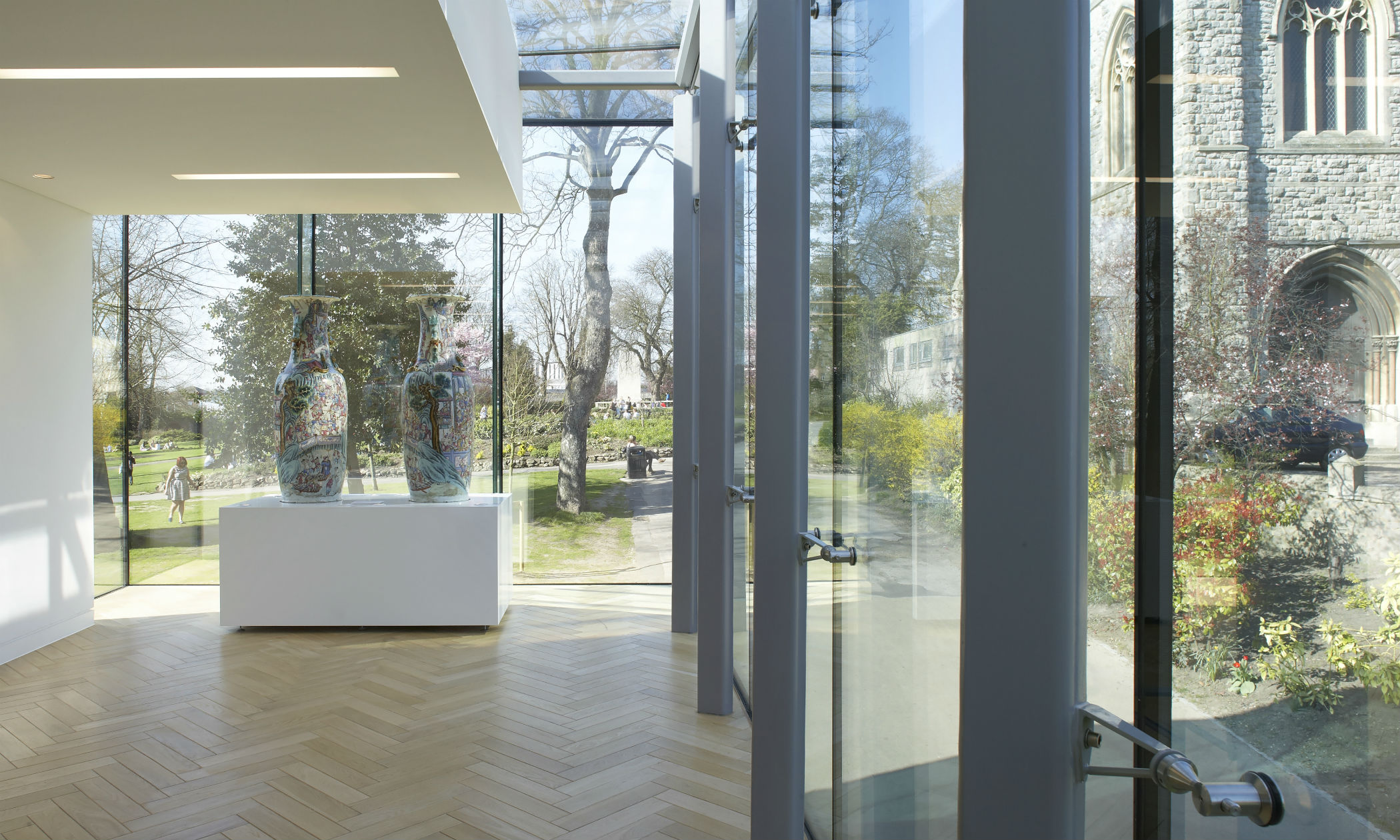
To celebrate the coming of winter we thought we’d share some of the beautiful snow scenes from the Japanese woodblock print collection at Maidstone Museum. Collections Manager, Samantha Harris, introduces the print collection and some of its seasonal highlights.
Collection
As part of its Japanese Art Collection, Maidstone Museum holds over 900 Japanese woodblock prints and books dating from the 17th, 18th & 19th centuries. The majority of these were donated in the 1920s by the local businessman and resident of Mote House (Maidstone), Walter Samuel, who purchased them during his business travels to Japan, and bought collections amassed by other collectors. These include works by the best known print artists, such as very fine female beauties by Utamaro and Gekko, iconic landscapes by Hiroshige and Hokusai, exceptionally rare actor prints by Kuniyoshi and Sharaku and early prints by Harunobu and Moronobu.
Early Prints
Woodblock printing had been used in Japan before the Edo period (1603-1868); mainly to produce religious texts. It wasn’t until the mid-17th century that the use of printing methods to produce art prints emerged. Initially the prints were black and white but by the 18th century colour was more common. As new colours were developed for printing, so new formats and genres emerged. From the early natural yellow, oranges and greens to the brighter prints of the 1830s when synthetic dyes including Prussian blue were available.
Popularity
Prints were produced in mass to allow the newly wealthy merchant classes to emulate the aristocracy and have their own art for their walls at home. They could be purchased inexpensively, costing the same as 2 bowls of noodles and this is the crux surrounding their survival, the prints were ephemeral by nature.
In an age before photography prints allowed people to capture and display the world around them in images,hence the name ukiyo-e, meaning ‘images of the fleeting floating world’ for a genre of prints. Although mass produced, Ukiyo-e was routinely censored, often as it celebrated seductive urban life and its pleasures! Popular themes of prints were Kabuki (actors), Bijinga (beautiful women) and fukei-ga (landscapes).
Japanese prints began to be collected in the West at a time when Japan had just opened up to the west with the coming of the Meiji era after 1868. They give us a window into a world that was entirely different to our own.
Print Production
There were 4 main groups involved in the production of woodblock prints in the Edo period, sometimes referred to as the ‘Print Quartet’:
Publishers who financially backed the production, commissioning artists to produce works that would be of interest to the public and sell well.
Artists, who would create an original, one-off version of the design, which was to be mass produced, and were often the famous names associated with the artwork e.g. Hokusai, Hiroshige, Utamaro, Kunisada etc.
Woodblock carvers, who would intricately carve the images created by the artist, brushstroke by brushstroke into the printing blocks, often made of cherry wood. This would be done over multiple blocks, per colour, which overlapped perfectly to create the final image. There was a huge amount of skill required in this stage of the process, recreating the fluid and iconic styles of different artists in wood.
Printers would ink and expertly overlay the multiple blocks to create mass-produced versions of the final image. This could include complicated effects for the sky and required precision lining up to ensure the ink did not overlap the detailed outlines.
The prints were expertly handcrafted and while the artists are remembered for the designs; it is the woodblock cutters and printers whose skill in reproducing them are to be admired (often anonymously) alongside them.
Wintery highlights
Landscapes
The majority of snowy landscapes (fukei-ga) in the collection are by the well-known Japanese artist Utagawa Hiroshige (歌川広重).
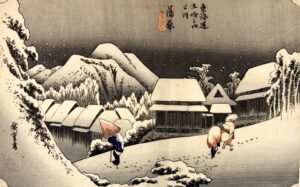
The Fifty-three Stations of the Tokaido (Tokaido gojusan tsugi no uchi). Kambara: Snow at night (Kambara: Yoru no yuki). Hoeido Edition. No.16. By Utagawa Hiroshige, 1831-1834 (Samuel Print 356)
This is a well-known print often referred to as ‘wounded knee’ due to later misprints on the figure to the right. They wear coverings to protect themselves from the snow, including one wearing a mino, a traditional Japanese cape-like garment made out of straw. The buildings in the background show the architecture of the time.
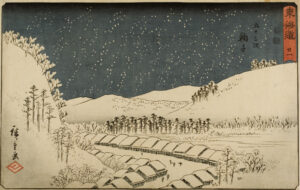
No. 21 from Tokaido (“Marusei Tokaido” or “Reisho Tokaido”) Series. From a set of 55. By Utagawa Hiroshige, 1850-1851 (Samuel Print 396)
Here the post station of Mariko on the Tokaido Way is represented by a snowy scene of a village situated in the bend of the hills. There are groups of pines and other trees, and small figures can be seen walking on the road between the houses.
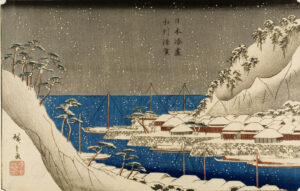
Nihon Minato Zukushi (Famous Harbours of Japan). Uraga in Soshu (Soshu Uraga). By Utagawa Hiroshige, 1840-1842 (Samuel Print 397)
Now famous as a site of Commodore Perry’s expedition, this blue water scene shows the surrounding harbour, quays and buildings (in red-brown). The surrounding hills are snow covered with clumps of green-white pines. Anchored are snow covered boats with their tall masts. The grey sky with snow adds to a chilly feeling image.
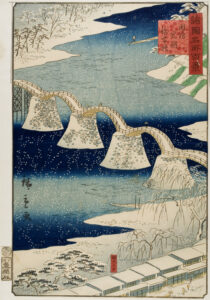
One Hundred Views of Various Provinces (Shokoku meisho hakkei). Kintai Bridge at Iwakuni in Suo Province (Suo Iwakuni Kintai-bashi). By Uoya Eikichi, 1859 (Samuel Print 407)
In this snow scene the bridge stands out in white against the blue of the river, the ice-blue shadows on the shore aiding a chilling colour scheme. The village in the foreground is Nishikimi.
Bijinga (beautiful women)
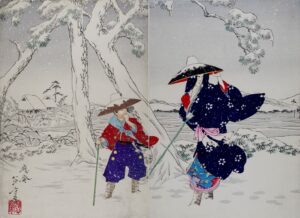
Female figure walking in the snow carrying a small baby. ‘Omae in the snow’. By Toshikata Mizuno from the Meiji period, late 19th Century (MNEMG.Temp.2016.887 & 8)
This scene is made from a pair of prints known as a diptych. Snow is falling and the landscape is covered with snow, a woman carries her child wrapped in red fabric under her clothes through the cold, her footprints are visible in the foreground. She is accompanied by a man; they both carry a bamboo pole to steady themselves in the deep snow. It is one of the later prints in the collection.
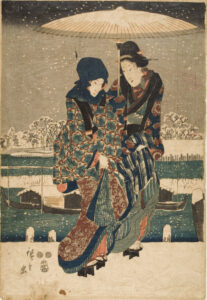
Views of the Four Seasons at Famous Places in Edo (Edo meisho shiki no nagame). Snow on the Sumida River (Sumidagawa setchu no zu). A triptych. By Utagawa Hiroshige , 1847-1852 (Samuel Print 337(ii))
This print is one of a triptych, a set of 3 complementary prints which make up a single image. The snowy river landscape and a moored boat can be seen in the background, with two women on river-side under a raised umbrella. Bijinga prints such as this show great detail in the sitter’s clothing, such as patterned kimono fabric.
Kabuki (actors)
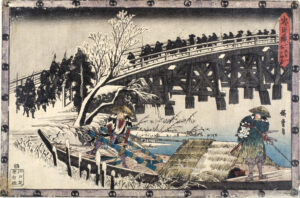
The Storehouse of Loyal Retainers (Chushingura). Night Attack, Part 1, Advances (Chushingura, youchi oshiyose). Act 11 Scene 1. By Utagawa Hiroshige, 1834-1836 (Samuel Print 38)
In this Kabuki (actor) print from the story of The Storehouse of Loyal Retainers (Chushingura), two ronin keep watch on a moored boat surrounded by a snowy landscape. More ronin can be seen crossing the bridge in the background.

The Storehouse of Loyal Retainers (Chushingura), Act IX. Kakogawa Honzo. By Utagawa Kunisada from 1853 (Samuel Print 237)
This kabuki (actor / theatre) print titled ‘Act IX. Kakogawa Honzo’ is also from the series depicting the fictional play ‘Chushingura (The Treasury of Loyal Retainers)’ based on an incident involving the 47 ronin. The character of Kakogawa Honzo is the chief councillor of the Momoi family in the story. Dating to 1853 this print is by the famous artist Utagawa Kunisada and shows the character wearing a komuso (basket) hat, with snow falling, settling on a brush fence behind him and a snow laden pine branch
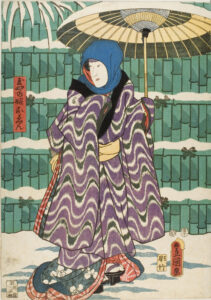
Young Wife Oen from the Tamaya (Tamaya no yome Oen). By Utagawa Kunisada (Toyokuni III), 1854 (Samuel Print 232)
This print shows a male kabuki actor in a female role (onnagata) depicted in a snowy scene. The bottom of the kimono can be seen around low clogs (komageta). Snow appears on the bamboo fence in background and on the drooping tree branches, as well as on the ground.
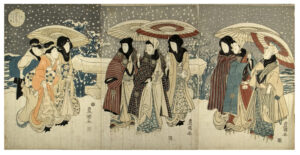
Actors in the Twelve Months (Yakusha juni tsuki). From a series of 36 prints (Sanjurokuban tsuzuki).
Twelfth Month: Falling Snow at Mukojima (Junigatsu: Mukojima yuki furi no zu). By Utagawa Toyokuni I, 1809. Triptych (Samuel Prints 477, 478, 479).
This final actor print is from a set of 36 prints, 7 of which are in the collection, each representing one of the twelve months. Here we see a snow scene in a temple garden. Three groups of actors, with some sheltering from the snow under umbrellas and displaying the Mon (symbol) of Ishimura Uzaemon IX’s clan. If you look closely, the 2nd figure from the right has a Tobako (tobacco pouch) suspended from their obi belt. The snow laden grey sky adds to the chilly atmosphere of the print.
Like what you’ve seen? Own a copy yourself
Copies of prints from the museum’s collection can be purchased online, they make great presents and are easy to post!: https://museum.maidstone.gov.uk/product-category/japanese-prints/
Also, for institutions, a touring exhibition of original prints is available for hire: https://museum.maidstone.gov.uk/japan-a-floating-world-in-print/
Would you like to find out more?
Additional blogs on the museum’s Japanese Print collection are available online:
Representation of Women and Femininity in Japanese Woodblock Prints: https://museum.maidstone.gov.uk/representation-women-femininity-japanese-woodblock-prints/
Kimono in Japanese Art: https://museum.maidstone.gov.uk/kimono-in-japanese-art/
A Confused Japanese Print: Toyoharu’s Dutch Views: https://museum.maidstone.gov.uk/confused-japanese-print-toyoharus-dutch-views/
Overview of Japanese Fine Art Collections at Maidstone Museums: https://museum.maidstone.gov.uk/explore/collections/japanese-decorative-art-prints/
References
Rosina Buckland, ‘Kabuki: Japanese Theatre Prints’. 2014. National Museums Scotland: Edinburgh.
John Reeve, ‘Japanese Art Close-Up’. 2014. The British Museum: London.
Rebecca Salter, ‘Japanese Popular Prints: From Votive Slips to Playing Cards’. 2006. A & C Black Publishers: London.
Adele Schlombs, ‘Hiroshige 1797-1858: Master of Japanese Ukiyo-e Woodblock Prints’. 2013. Taschen: Kӧln.
Ellis Tinios, ‘Japanese Prints’. 2010. The British Museum: London.
